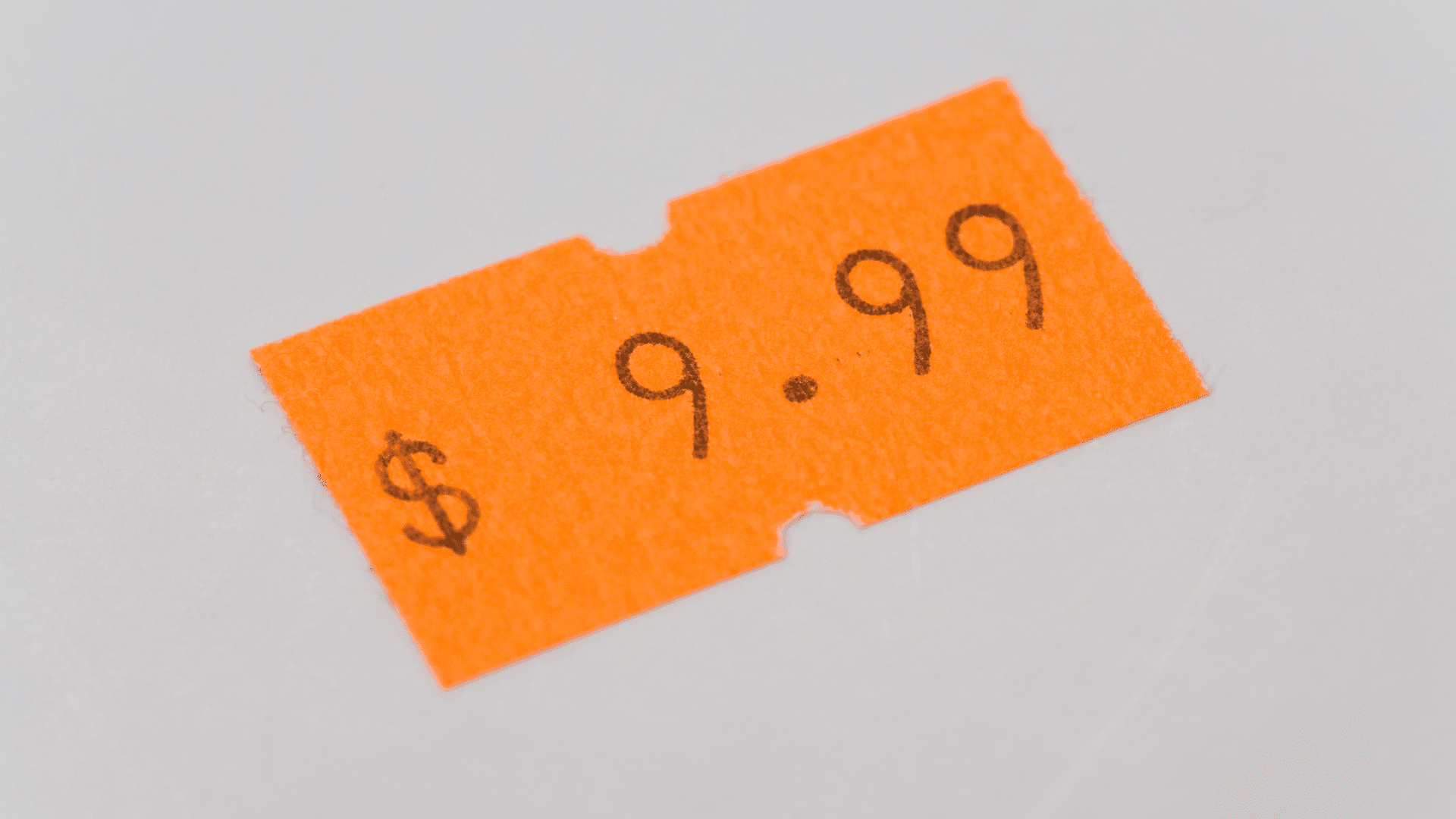
Is 99 Psychological Pricing Strategy Good For Your Small Business? 💸
Many small businesses have been taking advantage of the psychological effect behind 99 pricing strategy. By offering prices ending in 9, stores think they can encourage customers to make the purchase without feeling like they are overspending. Hence, it is a great way for small businesses to increase their sales and profits.
>Download Now: Free PDF How To Drive Pricing Strategy To Accelerate Sales & EBIT Growth
The problem is though, small businesses that use 99 pricing strategy might be missing out on potential revenue. 9-ending prices can put pressure on smaller businesses’ profit margins by cutting into their overall sales and profits. Moreover, using 9-ending prices can hurt businesses’ ability to develop a reputation for quality and value.
In this article, we’re going to discuss the nine-ending pricing approach for small enterprises. We examine the usage trends among enterprises. Then, we look at its benefits and drawbacks. We argue that 99 pricing strategy is not the best strategic pricing practice possible and that small businesses should instead think about more efficient, value-based alternatives.
At Value Culture, we believe small businesses shouldn’t be reluctant to get creative with savvy pricing strategies to draw in more customers and increase profitability. By the end, how to make better pricing decisions for your small business.
Why Are Small Businesses Using 99 Psychological Pricing Strategy?
As early as 1880, Macy’s newspaper advertisements touted prices like $.99 and $1.99 proclaiming them to be “positively the best bargains ever offered, and cannot be equalled by any other house.” Since then, 9-ending prices have been (over) used ever since. From cheese, crackers, bottled juices, canned soups, dish detergents, painkillers, cigarettes, toilet paper, soft drinks, and shampoos. Just about every category and industry except luxury product pricing uses 9-ending prices. This means even small businesses use it too.
The prevalence of this 99 pricing strategy is believed to be even higher among small businesses, as these businesses generally have smaller budgets and fewer resources to devote to marketing efforts.
It has been estimated that over 40% of businesses in Australia with a turnover of up to $2 million use 9-ending prices. The use of 9-ending prices has been found to be particularly popular in the retail sector, where customers are often looking for discounted items or special offers. Service providers, such as hair salons and auto repair shops, have also been using this strategy.
In fact, studies have shown that the majority of consumers expect to see prices ending in 9 when they go shopping. For small businesses and retailers, 9-ending prices can be a powerful tool for driving sales and increasing profits. However, it is important to note that this strategy should always be used in moderation as too much reliance on ending prices in 9s could negatively affect customer perceptions of the business.
Discussion On 99 Consumer Psychology And Pricing Strategy
Based on years of data from American grocery stores, when a price point ends in 9, the product tends to be on average 18% more expensive than when that same item’s price has a different ending. This means on average when products are priced with a 9-ending, they are often bad deals.
The origin of the 99 pricing strategy has always been a psychological trick – right back from 1880 when it was first used and originated. The overuse of 9-endings in retail comes down to the simple fact that 9-endings can and do drive sales: Consumers still largely associate 99-cent pricing with good deals. Even when they are bad deals. Saying this, though, a growing number of consumers are already wise to the 9-ending trick too.
So the question is should retailers overuse the 99 pricing strategy to drive sales? In our opinion, no.

9-ending prices can lead to customer confusion, as they may assume they are getting a better deal when in reality the savings isn’t significant. This pricing strategy can also lead to customers being less engaged with the product or service itself. Rather than investigating the features and benefits, they are simply looking for the best price ending in “9” and may not be making an informed decision.
Another disadvantage is that it can limit pricing flexibility and creativity for small business owners. Instead of customising their price points according to market conditions or other factors, they are limited to only those prices that end in “9”. This can make it harder for small businesses to compete with larger ones that have more price points available to them.
The 99 pricing strategy can be more damaging than beneficial for small businesses.
For small businesses, 9-ending pricing can have a detrimental effect on their bottom line and limit their ability to grow. Customers become accustomed to seeing prices ending in 9, which makes it harder for businesses to raise prices when needed. This is especially problematic for businesses that operate on thin profit margins, as they need to charge higher rates but still remain competitive.
Additionally, 9-ending prices can lead to a perception of lower quality and may damage the reputation of the business in the long run. By understanding their costs and market dynamics, businesses can make better pricing decisions that will help them succeed and grow.
9-ending prices are an overused gimmick; and strategic pricing has moved on. There are much better price strategies, actions and interventions that could be used to get equal if not more results and build trust at the same time.
Implications Of Strategic Pricing For Small Businesses
Value-based pricing is a better alternative to 9-ending prices. This type of pricing model works on the premise that you set your price based on the value customers receive from your product or service rather than what the market will bear. Value-based pricing also helps to build trust with your customer base. Customers tend to trust companies that price their offerings in relation to the value they offer rather than just looking at the bottom line.
Furthermore, value-based pricing allows you to differentiate yourself from your competitors and profit margins by charging what customers are willing to pay for the true value of products or services. This type of pricing strategy can be particularly beneficial for small businesses as they seek to maximise their profits while providing superior customer service.
To implement this type of pricing strategy, small businesses should assess their customer base and understand what factors influence their willingness to pay.
These could include the quality of the product or service, convenience, brand loyalty or any other feature that affects the value they place on it. Knowing this information will help you create an optimal price that captures all of the value your product or service provides while maintaining a competitive advantage in the marketplace.
Small- and medium-sized firm employees frequently have their hands full of workloads. But, our findings show that with the right set-up and pricing plans in place, incremental earnings gains can begin to occur in less than 12 weeks. After 6 months, your teams can capture at least 1.0-3.25% more margin using better price management processes. After 9-12 months, businesses often generate between 7-11% additional margin each year as they identify more complex and previously unrealised opportunities, efficiencies, and risks.
>>> Setup A Meeting With An Expert <<<
Bottomline
Rather than using the 99 psychological pricing strategy, companies should consider factors such as the value they bring to customers and the market’s willingness to pay. That way, small businesses can maximise their profits while also ensuring that prices reflect fair market value. Value-based pricing allows companies to adjust their prices based on market conditions or customer demand changes rather than relying on 9-ending psychological pricing tactics.
Ultimately, 9-ending prices can be a great way to attract customers in the short term, but small businesses should consider their long-term goals before making an investment. When considering a pricing strategy, companies should consider their brand’s position in the market, customer feedback and trends within the industry. With proper planning and research, businesses can ensure they make informed decisions on pricing that will lead to sustainable growth and success.
For a comprehensive view of ensuring the continuous growth of your business, Download a complimentary brochure on How To Drive Pricing Strategy To Accelerate Sales & EBIT Growth.
Are you a small or medium-sized business in need of help aligning your pricing strategy, people and operations to deliver an immediate impact on profit?
If so, please call (+61) 2 8607 7001.
You can also email us at team@valueculture.com if you have any further questions.

